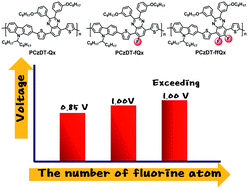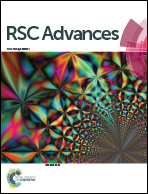Medium bandgap copolymers based on carbazole and quinoxaline exceeding 1.0 V open-circuit voltages†
Abstract
Open-circuit voltage (VOC) is an important parameter in determining the performance of polymer solar cells (PSCs). Given the desire for superior VOC values in PSCs, we have designed and synthesized a series of ‘medium bandgap’ donor–acceptor (D–A) copolymers containing carbazole (Cz) and quinoxaline (Qx) (PCzDT-Qx, PCzDT-fQx, and PCzDT-ffQx). As a result of their deep-lying HOMO levels (−5.45 to −5.61 eV), high VOC values are achieved in PSCs with the resulting copolymers, despite the expense of short-circuit current density (JSC) and fill factor (FF) parameters. In this study, in addition to the best power-conversion efficiency (PCE) of up to 4.03% from PCzDT-fQx-based on PSCs, we have demonstrated a VOC value exceeding 1.0 V with PSCs of PCzDT-ffQx, which is among the highest VOC values achieved to date. Moreover, a comprehensive investigation on the mechanism of charge recombination and transport characteristics can determine a clear structure–property correlation in this class of molecules, which is helpful for designing better materials with maximum VOC without scarifying other key photovoltaic parameters.


 Please wait while we load your content...
Please wait while we load your content...